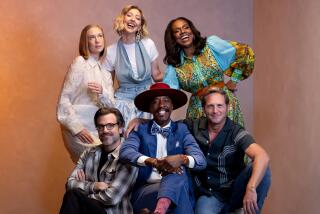Commentary : ‘THE HONEYMOONERS’: HOW SWEET IT WAS
- Share via
Ralph: One of these days, Alice, one of these days!
Alice: What? What, “one of these days”?
Ralph: You’ll find out when the time comes.
Every good “Honeymooners” fan knows what “what” was: “Pow, right in the kisser.” But that came later. The dialogue is from one of the first “Honeymooners” sketches ever done, televised live so long ago that Audrey Meadows had yet to assume the role of Alice Kramden, long-suffering spouse to Jackie Gleason’s immortal bus driving Ralph.
The Museum of Television and Radio recently unearthed the lost “Honeymooners” sketches and screened them in Los Angeles and at the museum’s main building in New York, where showings continue through June 13. They show “The Honeymooners” as a work-in-progress, something Gleason developed before he became one of TV’s biggest stars.
In addition to the museum’s priceless discovery, which may eventually make its way to home video, CBS Video has just announced that the 39 filmed “Honeymooners” shows Gleason did much later, during the 1955-56 TV season on CBS, will finally become available on videocassette. What CBS calls the “Classic 39” will be released on 20 tapes, the first 10 to appear in stores in May, the other 10 in October.In the early “Honeymooners” sketches culled by the museum, one can see and savor the birth of genius.
At this point, the idea was still raw and unpolished, and the set was so primitive and cheap that a painted backdrop of tenement windows, viewable from Ralph and Alice’s tiny apartment, shook whenever Ralph slammed the door. Alice was played by Pert Kelton, a saucy character actress seen several years, and several pounds, later as Marian the Librarian’s mother in stage and screen versions of “The Music Man.”
On Oct. 5, 1951, an announcer introduced the first “Honeymooners” sketch and told the audience that it dealt with the sea of matrimony and “two brand new characters whose boat has sprung a leak.” The curtains parted to reveal the shabby flat and the band played Irving Berlin’s “Always.”
The early sketches were only about seven minutes in length--roughly five minutes of feverish bickering followed by two minutes of Ralph’s sheepish apologies. Art Carney appears in the first sketch but not as neighbor and sewer worker Ed Norton; he plays a cop who is showered with flour when Alice throws it out the window in a fit of pique.
Gleason and company were setting in place “Honeymooners” rituals that would become icons. Each sketch ended with a hug of mutual forgiveness. Even though the tone was harsh, you knew that Ralph and Alice loved each other. The first time Gleason said, “Baby, you’re the greatest,” Dec. 7, 1951, is a date which will live--but not in infamy.
Those who cannot remember the past are condemned to see it in reruns. TV recycles everything whether trash or treasure. “The Honeymooners” is a treasure.
At the end of one sketch, Ralph waxes philosophical during his apology. He wonders aloud why Alice puts up with him. “I guess every now and then, I give you a laugh or something,” he speculates. “Whenever we’re in trouble or anything and we get a laugh, things look a lot brighter.” How true. That’s one reason “The Honeymooners” will never die.
More to Read
The complete guide to home viewing
Get Screen Gab for everything about the TV shows and streaming movies everyone’s talking about.
You may occasionally receive promotional content from the Los Angeles Times.





